It is hard for any South African to clearly express the gamut of emotions they felt on the death of Nelson Mandela.
Flow Communications is a long-term communications partner of the Nelson Mandela Foundation (NMF), which houses the Nelson Mandela Centre of Memory and which was one of the focus points for events organised on his passing to celebrate his life and legacy.
Flow's work involves, among many other things, running this website, including the programming, content, design and hosting aspects of it, in partnership with the Foundation.
Keeping the site up while it attracted record levels of traffic following late former President Mandela’s death was one of the tasks Flow needed to focus on, as well as writing and photographing the many events that followed his death across the country, culminating in his funeral in Qunu in the Eastern Cape.

Nelson Mandela's cortège makes its way to Qunu. Photo by Tara Turkington
It was a special time in South Africa, and the Flow staff feel proud and privileged to have been working here at this time.
Below, some of the staff who work for Flow and who were involved in Madiba-related work, reflect on their experiences.
Said Tiffany Turkington-Palmer, Flow’s managing director: “It was an honour for the Flow team to work so closely with the NMF team and we are continually humbled by their teamwork, their dedication, their persistence and the determination to continue to live Madiba’s legacy through themselves and through the Foundation. While the country mourned and the media had their moment, the team at the NMF worked tirelessly and selflessly, often through the night, to help deliver Madiba’s message to the world.”
Said Flow content developer and journalist Kate Rau, who was based at the Foundation in the week following Mr Mandela’s death and helped publish over 90 articles on the website in that time: “Looking back, I must admit that I struggle to discern exactly what I did for the Nelson Mandela Foundation each day. It’s as if I’ve been in a state of shock, where happenings, chance meetings and dates have become mixed up in my memory.
“I have snapshots, highlights if you will, of events that remain imprinted – I vividly recall Oprah walking into the Centre of Memory building and smiling at my colleague, Daphney Mngomeni; I remember dancing to a lullaby in the marquee at the Foundation, serenaded by the Joyous Celebration Choir, with the Reverend Jesse Jackson putting his arms around my waist and smiling with me; and I can still hear Johnny Clegg’s distinctive guitar tinkling as he sang Asimbonanga with the Soweto Gospel Choir.
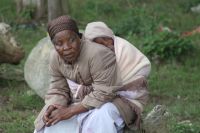
A Qunu resident waits with her baby to welcome Mr Mandela home to his final resting place. Photo by Tara Turkington
“I remember tears falling and holding my hand over my mouth when, during a live Google Hangout from the Foundation’s auditorium, Archbishop Desmond Tutu addressed his friends, saying ‘Bye Richard [Branson], bye Your Holiness [the Dalai Lama]’, as he waved goodbye and giggled in the sweetest moment of gentle joy and childlike affection. (You can watch the full event here.)
“I recall watching South Africa Deputy President Kgalema Motlanthe getting ‘miked up’ behind the marquee before delivering an excellent reflection on Madiba’s time spent as a young freedom fighter. I remember the thrill as United Nations Secretary General Ban Ki-moon arrived at the Foundation to deliver a personal tribute to the man he will forever remember for saying: ‘It wasn’t just me, it was ordinary South Africans who helped shift apartheid.’
“I can see the expression on Elinor Sisulu's face when she begged South Africans to honour all stalwarts of the struggle, and the determination in tone when United States Ambassador to South Africa Patrick Gaspard reminded the audience that tears and sweat are made of the same stuff, yet tears will bring pity and sweat will bring change.
“I watched as jazz legends Sipho ‘Hotstix’ Mabuse and Jonas Gwangwa lifted their instruments in tribute to the man they loved, world-renowned artists in their own right who themselves felt privileged and honoured to be paying their respects to Khulu.
“Most of all, I remember the streams of people who every day, from early till way past the sun had gone down, came to pay tribute to the man they loved. They would write messages, bring flowers, light candles, sing and cry in the space he created for his memory.
“I am honoured and humbled to have worked with the team during this time. I have treasures of memories, little nuggets and gems of sights, smells and sounds that I’ve tucked away for safekeeping – and although I never once met Mr Mandela, I have had the privilege of meeting his spirit in the people who share his vision, his passion and his determination.”
A Qunu resident raises his fist in the traditional anti-apartheid 'power salute'. Photo by Tara Turkington
Mel Feris, Tara Turkington and Zintle Mtyeku travelled to the Eastern Cape to cover Mr Mandela’s funeral. Said Feris of the experience: “I’m still trying to fully absorb the enormity of the two weeks following the time the call came on December 5, notifying me that Nelson Mandela had died.
“It was followed by days of long hours, little sleep, dealing with bureaucracy (in getting accredited for the funeral, for example), and recording and interacting with people wanting to share their memories of Nelson Mandela.
“Tara and I were so lucky to get seats on the last plane into Mthatha on the morning that Nelson Mandela’s body was being flown in from Pretoria. Almost every passenger on board was flying in to attend the funeral.
“In Mthatha, long lines of people and marshals lined the streets for hours, waiting for the body to arrive. It would be almost eight hours before the body would arrive and go on its last journey to Qunu. The crowds just grew, singing struggle songs and hymns, waving flags. There was no mourning, just a celebration of the life of the icon. Young and old had stories to tell of why they were there.
“As a journalist, it meant hours and hours of work – talking to people, recording the atmosphere and what was happening. It was exhausting but possibly the most memorable event I’ve covered as a journalist. On a personal level I’m still coming to terms with this great loss – but these past weeks have shown me what amazing people South Africans truly are.”
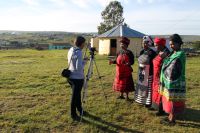
Flow's Zintle Mtyeku in action in the Eastern Cape, her home province. Photo by Tara Turkington
Added Mtyeku of her experience, “Helping cover Nelson Mandela’s funeral in Qunu in the Eastern Cape was a highlight for me. Not only was it great to be surrounded by the people of this humble village, it was amazing to take part in mourning and celebrating the life of a world icon.
“Meeting and interviewing people who love both Mr Mandela and the country we have become strengthened my patriotism. I wouldn’t trade this experience for anything.”

Members of the media and the Qunu community gather to catch a glimpse of Mr Mandela's cortège arriving. Photo by Tara Turkington
Flow’s programming team was also in full swing during this time, working round-the-clock shifts to monitor our clients’ servers. One of the things we’re most proud of is keeping the NMF’s site up at all times, when many other sites failed for considerable periods.

Flow programmer Stephen Frank scaling up the Nelson Mandela Foundation's servers. Photo by Tiffany Turkington
Said Richard Frank, head of Flow’s programming team, “We managed the servers on the night that Madiba died. We had to quickly scale to four servers from one to manage the traffic load.
“The development team stayed up the whole night to ensure there was 100% uptime. I was in the Seychelles at the time, and it was moving to see what Madiba meant to this small island nation – there were three days of mourning and flags flown at half mast at every government building, including the many police stations dotted around Mahe, the main Seychelles island.”
Richard’s fellow developer, Reatile Tshikalange, added: “I was part of the day shift. I monitored the NMF’s servers and applied changes to the site when requested. Ensuring optimum uptime was a major concern, and there was no room for mistakes or development errors – ‘the world is watching us’ were words constantly in our thoughts.
“Doing work for the NMF is always an honour. I have also been touched, moved and inspired by the man who shaped the nation. It was special to be a part of history in my way, in a geeky way.”
Added web developer Stephen Frank, who also worked the night of Mr Mandela’s death: “As someone who regularly tends our flock of web servers I was well attuned to the fact that they were all experiencing an unprecedented amount of traffic moments after the news was announced.
“For nelsonmandela.org, the web servers were serving up to 1 000 times the amount of traffic experienced on an average day. Having done some capacity planning beforehand, we were able to keep our networks open and the communications rolling out during this period of intense traffic.”
A newspaper bill bids Madiba farewell in the Eastern Cape. Photo by Tara Turkington
All members of Flow’s Cape Town office were also involved in communicating the stories around Madiba’s death and life. Roy Barford, Flow’s Cape Town manager, remembered: “After the announcement of Nelson Mandela’s passing on the evening of December 5, I pulled an all-nighter while communicating the story. Whenever I started feeling tired, I thought of the many years Madiba sacrificed to bring democracy to South Africa and this inspired me to keep going.
“It’s been a very reflective period for most people in South Africa, and indeed many other parts of the world. One man made a massive difference to the lives of millions and inspired millions, and while I will never match the achievements of Madiba, I can make a difference to the lives of others and I can inspire others – this is the best way I can honour him.
“Flow has done a lot of work promoting the ideals of Nelson Mandela for many years, and I’m proud to have played my small part whenever required.”
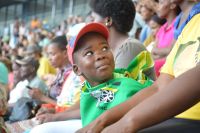
Emihle Felebayi attended the event at Cape Town Stadium with his mom, Tamara, both from Khayelitsha. Photo by Andrea Weiss
Said Andrea Weiss, who works as a journalist and editor in our Cape Town office, “Fortunately I was able to attend the amazing tribute at Cape Town Stadium. I just loved this little boy (Emihle Felebayi) who attended the event with his mom, Tamara (both from Khayelitsha). I am sure it’s a memory that they will treasure. And who could forget Annie Lennox’s surprise appearance and her protest song about HIV/Aids and violence against women?
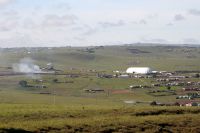
Mr Mandela's funeral and burial site (the smoke is from the guns fired in an official salute on the morning of his funeral). Photo by Tara Turkington
Journalist and media developer Stuart Buchanan, who is also based in Cape Town, said: "The next day felt quite sombre at first, but going out into the streets of Cape Town to take photos changed that. People were instead in celebration mode and remembering the incredible life Mr Mandela lived, expressing themselves through song and dance. It was an honour to edit together a short video of the reaction from Mthatha residents for the Nelson Mandela Foundation’s website.
“As a young journalist, I always knew this day would come, and I feel proud of the coverage I was able to provide for the millions of visitors around the world who want to share in the Madiba story.”
Across the country, Cassidy Parker, an account director for Flow PR, is currently based in Pretoria on a contract for a government agency, which, she said, gave her "a vantage point and a collection of experiences that I expect will always resonate somewhere behind my rib cage.
“Over the course of the three days that Mr Mandela lay in state in the Union Buildings, Pretoria was transformed. Roads were closed, alternative routes opened, and an endless ribbon of people wrapped themselves around city blocks. Vendors sold African National Congress paraphernalia, bottles of water and ice cream. People stood, shuffled forward, made friends, talked and sang. Without fail, the days were blue-skied and beautiful.
“Each morning, my walk to work was halted by the guard of honour lining Madiba Street. I arrived moments too late for the cortège on the first day, but was standing on the sidelines on the second and third, surrounded by an enthusiastic and smiling crowd, cameras in hand.
“The colours of the South African flag dominated, and spontaneous renditions of the national anthem and Asimbonanga induced goosebumps, as did the ululations of the women. These sounds especially would follow me to the office, where music could often be heard in the passage outside my office or echoing from some far-off corridor.
“Forever, when we remember this time, sentences will begin with the words: ‘When Mr Mandela died, I was...’ Though by no means exceptional, I am grateful that when Mr Mandela died, I was working for the government, a stone’s throw from the buildings in which he once held office, and, in my little way, was able to witness what losing him meant to us.”
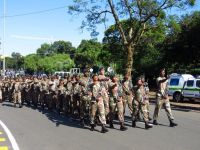
Members of the South African National Defence Force following Mr Mandela's cortège in Pretoria. Photo by Cassidy Parker
Many others at Flow covered one or two events, and helped to support the rest of our work while so much was being poured into the Madiba coverage.
Said content developer Daphney Mngomeni, who has just started at Flow, in her first job since studying: “Covering the tribute event, ‘Comrades in Conversation: Deputy President Kgalema Motlanthe and Ilse Fischer remember Madiba’, on Saturday 14 December was an enlightening and thought-provoking experience for me. The words of Deputy President Motlanthe and Ilse Fischer Wilson really opened my eyes up to just how much people like Nelson Mandela, Oliver Tambo, Chris Hani and others went through and did in the struggle for democracy.”
Said Kolosa Vuso, also a new Flow recruit: “I did the ‘Bikers for Madiba’ story, and one of the bikers I interviewed said they were there that morning honouring Madiba by doing something they love. I thought that was really brilliant because honouring someone by doing something you enjoy is not so much a chore, but a gift. It was a privilege to cover the event; the atmosphere was electric – it was more celebratory than anything.”
Mpho Lukoto, who also helped cover some of the events, recalled: “I had tried to keep a respectable distance from the death and all the activity around it within and outside the company. I was thankful for Mr Mandela, what he had done, what it meant for me, but I felt like just one of the millions. And on Saturday 14 December, at the Nelson Mandela Centre of Memory, I realised that it had more to do with me than I cared to acknowledge.
“I am who I am because of his commitment – and the commitment of his fellow activists – to the liberation of South Africa. So I am glad that in my own small way, I was able to be a part of documenting his history.”
Flow’s graphic design team also played its part, putting up new visuals across many websites and developing new designs, memes and buttons at the speed of light. Said designer Ryan Levenson: “Working with the Nelson Mandela Foundation is always inspiring, and I feel privileged to be part of carrying on Mr Mandela’s legacy. After Madiba’s passing, the office was buzzing with people working on Mandela tributes. I was fortunate enough to work on visuals at this time.”
Danielle Melville, the Foundation’s Director of Communications and Outreach, said: “It was important to create a space of living memory and reflection, both virtually and physically, at the time of Madiba’s passing – something tangible that could be experienced and used by individuals in their own way. Memory offers us healing and is a means of respect.
"The Centre of Memory provides a hub for this but also allows the journey started by Madiba and his comrades to continue. Flow aided us in making this a reality. Flow worked tirelessly and with passion by our side as we dealt with a nation's and indeed the world’s grief and we thank them deeply.”
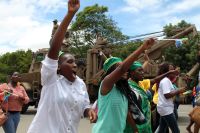
Celebrating Mr Mandela's life in the streets of Mthatha. Photo by Tara Turkington
Flow’s CEO, Tara Turkington, said: “On a personal note, travelling to the Eastern Cape for Madiba’s funeral was a highlight of my working life. In Mthatha on the day before he was buried, people were dancing up and down the streets, pumping the air with power salutes, and singing songs of celebration for his life and contribution to South Africa. With the police presence, army Casspirs, ANC colours and old struggle songs, it was reminiscent of the anti-apartheid protests of the 1980s. Except in this case, everyone was smiling.
“As we move forward into 2014 and beyond, we as Flow will strive to communicate and develop Mr Mandela’s legacy however we can. And, of course, each of us in our individual capacity can work in small ways to fight poverty, injustice and inequality and to build a better world in which human rights are ever stronger.”